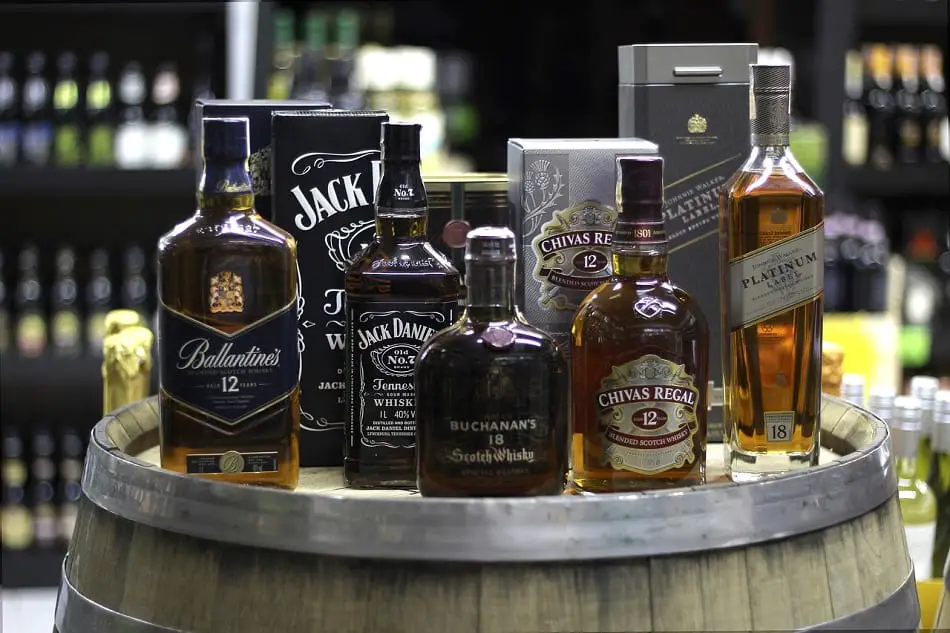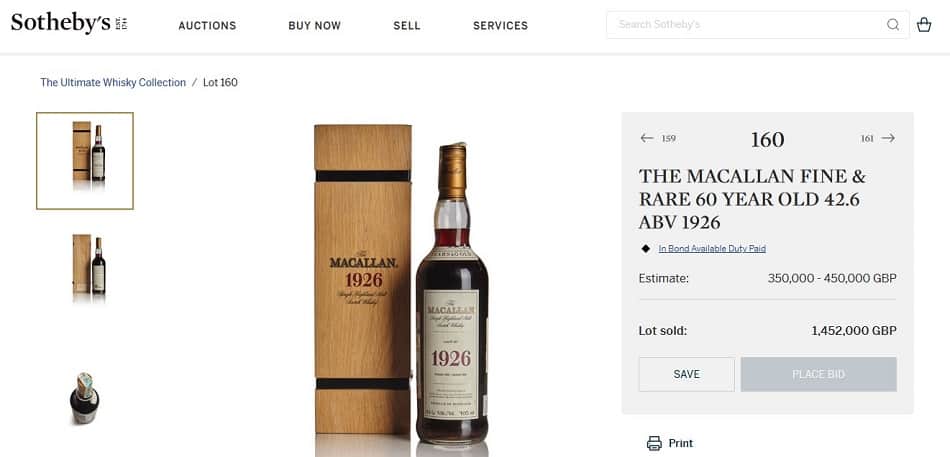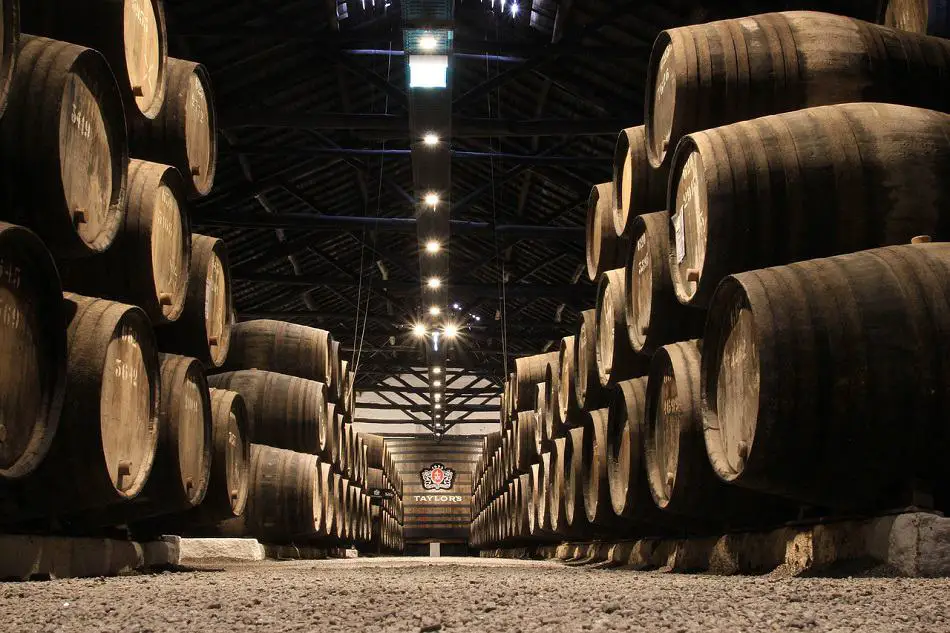Whiskey can be quite expensive, even if it’s not old and rare and with a price tag of hundreds of thousands of dollars. I wanted to find out more about how much whiskey costs, so I looked at the price of about 3000 of the most popular whiskeys and here’s what I found.
Whiskey typically costs between $20 and $500, although there are some that are under $20 and many that are $500 plus. Within this typical price range most whiskeys seem to fall into one of two narrower price ranges: $20 – $70 and $100 – $500, with more whiskeys falling into the lower price range than the higher one.
The rest of this article will look at how the price ranges of whiskey varies by country, region and type of whiskey, which is very useful whether you’re looking to budget or don’t mind spending a little more. We’ll also look at the reasons behind the cost of whiskey, what that means for different whiskey types and list some popular whiskeys in different price ranges.

The Price of Whiskey by Country, Region and Type
The following table shows the price of whiskey by country, region and type.
When reading the table, please bear the following in mind:
- All the data is taken from the 3000 (approximately) whiskies that I looked at.
- All the price ranges listed in each row, together make up the price ranges of approximately three quarters of that type of whiskey.
- Price ranges that are bolded have significantly more whiskeys in them than those of the same type that are not bolded.
| Price Range(s) | |
| American Whiskey | |
| Bourbon | $30 – $70 & $70 – $100 |
| Malt Whiskey | $75 – $100 & $100 – $250 |
| Blended Whiskey | $25 – $80 & $90 – $100 |
| Rye Whiskey | $30 – $60 & $70 – $100 |
| Scotch Whisky | |
| Highland Single Malt | $40 – $70 & $100 – $200 |
| Lowland Single Malt | $40 – $95 & $100 – $350 |
| Campbeltown Single Malt | $35 – $100 & $300 – $500 |
| Speyside Single Malt | $35 – $70 & $100 – $300 |
| Islay Single Malt | $40 – $85 & $100 – $500 |
| Island Single Malt | $35 – $70 & $100 – $350 |
| Blended Malt | $30 – $60 |
| Grain Whisky | $25 – $55 & $100 – $300 |
| Blended Whisky | $20 – $80 |
| Irish Whiskey | |
| Single Malt | $30 – $90 & $100 – $200 |
| Single Pot Still | $30 – $100 & $100 – $250 |
| Grain Whiskey | $35 – $65 |
| Blended Whiskey | $30 – $60 |
| Japanese Whisky | |
| Single Malt | $55 – $85 & $100 – $300 |
| Blended Malt | $40 – $100 & $100 – $150 |
| Blended Whisky | $30 – $90 |
| Canadian Whisky | $25 – $90 |
As you can see most whiskey types have two price ranges, one (relatively) cheaper and one more expensive. This makes sense when you think about it because brands want to target two types of consumers: those who can or don’t mind paying for very high-quality whiskeys and those who aren’t wealthy.
Interestingly, it seems that there are more whiskeys in the lower price ranges than in the higher ones. I assume this is to do with the fact that there are more of one type of consumer than the other.
The lower price ranges can start as low as $20 but they mostly start a little higher at $30, $35 or $40. Often the lower ranges end at $60, $70 or $80 which also makes sense, because those who wouldn’t buy a whiskey in the higher price ranges will be looking at the lower end of the lower ranges, and those who would buy a whiskey in the higher price ranges are now encouraged to do so!
Despite this, most of the higher price ranges don’t go above $350. This is presumably because even if you’re prepared to pay over $100 for a bottle of whiskey, you’re probably not prepared to pay that much more.
Single malts are the most expensive whiskeys with the lower end of their price ranges starting a little higher, and the higher end of their price ranges ending a lot higher. Interestingly, there are more Japanese single malts in the more expensive $100 – $300 price range than in the cheaper $55 – $85 price range!
Blended and grain whiskeys are the least expensive whiskeys with most having only the lower price range and even then, starting at some of the lowest prices. This is to do with the reasons behind the cost of whiskey which we’ll get into a bit later.
Between countries and regions, the price ranges of whiskey are quite similar, with the exception of Canada whose whiskey prices fall into one range that starts very low and Scotland whose higher ranges end very high.
The Price of Whiskey by Rarity
Rarity is something that affects price and I wanted to see how it did so in whiskey. Rarer whiskeys are those that are:
- Older
- Cask strength
- Single barrel
- Small batch
The following table shows the price of whiskey by these types of rarity.
| Price Range(s) | |
| 10-Year-Old Whiskey | $35 – $70 |
| 12-Year-Old Whiskey | $30 – $80 |
| 15-Year-Old Whiskey | $45 – $90 |
| 18-Year-Old Whiskey | $60 – $100 & $100 – $350 |
| 21-Year-Old Whiskey | $100 – $300 |
| 25-Year-Old Whiskey | $130 – $500 |
| 30-Year-Old Whiskey | $120 – $500 & $500 – $1000 |
| 40-Year-Old Whiskey | $200 – $2000 |
| 50-Year-Old Whiskey | $500 – $1000 & $3000+ |
| Cask Strength | $55 – $100 & $100 – $250 |
| Single Barrel | $40 – $100 & $100 – $300 |
| Small Batch | $35 – $100 & $100 – $120 |
As you can see, all types of rarity affected the price of whiskey with age doing so the most. It’s very clear why the most commonly bought whiskeys are 12, 15 and 18 years old, why 21- and 25-year-old whiskeys are bought every so often and why whiskey that’s 30 years or older will only be bought once in a lifetime. Or less.
The rarity of cask strength, single barrel and small batch whiskeys, affected the lower price ranges but not the higher ones. The prices of the lower ranges start high and go all the way to $100, which indicates that the whiskeys in these ranges are somewhat more expensive than normal lower price range whiskeys.

How Much Whiskey Costs Explained
Now we’ve seen how much whiskey costs it’s time to look at why. There are four factors that affect the price of whiskey.
The Ingredients
Whiskey is made from grain, water and yeast and believe it or not these can vary in price. More expensive whiskeys are often made from more expensive grains, water and yeasts that are fresher and of a higher quality.
The Distillation Process
Some whiskeys are distilled in pot stills and others in column stills and using the former is more expensive. This is because pot stills work by distilling alcohol in batches, whereas column stills work by distilling alcohol continuously. The longer process makes it more costly.
Additionally, not all distilled alcohol is equal. Alcohol at the beginning of the distillation run may be dangerous to drink and alcohol at the end is weak, and both are pungent and not great taste wise. What is really desired is alcohol from the middle of the run which doesn’t contain any unpleasant impurities or odors. Of course, this also means you’ll have a lower volume of alcohol, which is why the way the distillate is cut to exclude more or less of the bad alcohol, affects the price of whiskey.
The Aging Process
Whiskey is left to age for many years in barrels and this has a huge impact on the price. If something is going to take decades to produce it will cost that much more. Not only that, each year 1% – 2% of whiskey stored in barrels evaporates so depending on the length of the aging process, by the time it’s over you could end up with significantly less whiskey than when you started, which also drives up the price.
Add to that the cost of the barrels (especially if they are of high quality), the cost of storage, the cost of maintaining the storage area properly (i.e. in a way that protects the whiskey and stops it from becoming ruined), and the risk associated with holding on to barrels of whiskey for a long time and you can see why whiskey is the price it is.
Brand and Marketing
The cost of whiskey is also determined by brand and marketing. Brands that have a reputation for delivering quality whiskeys can charge more, as can brands that have established themselves as making premium, luxury whiskeys.
Hype that comes from marketing or from demand (if a whiskey is popular or there is insufficient stock) will also affect a whiskey’s price.

How Much Different Whiskey Types Cost Explained
Now we know why whiskey costs what it does, we can also understand the difference in cost between different types of whiskey.
Grain Whiskey
Grain whiskey is (often but not always) one of the cheapest of all types of whiskey, because in all the factors that affect price, the cheaper option is selected.
They’re made from cheaper grains like corn, rye, and wheat, they’re distilled in column stills, they’re aged for a short amount of time because they become drinkable relatively quickly, and they don’t have the marketing that says these are high-quality whiskeys that you should be paying a lot of money for.
Single Malt Whiskey
At the other end of the spectrum, single malt whiskey can be some of the most expensive of all types of whiskey, because in all the factors that affect price, the more expensive option is selected.
They’re made from premium ingredients, they’re distilled in pot stills with some of the widest cuts, they’re aged for a very long time (12, 15 & 18 years are common) and not only are they marketed as high-quality products, it’s also a common perception among us drinkers, that single malts are the best whiskeys.
There’s another less apparent reason why single malts cost more than other whiskeys.
Usually, single malts don’t come from a single cask but from a blend of malts made by one distillery. This is because each batch of whiskey tastes different and in order for a distillery to produce a whiskey with a consistent taste, it has to mix the different whiskeys from different runs, different casks and different ages.
This means that if you have a bottle of 12-year-old whiskey, some of it or even a lot of it could be much older than that. By law, the age stated on a bottle of whiskey is only that of the youngest in the blend not the majority. On the one hand it’s great because you could be drinking whiskey that’s older than you think, but on the other hand the price will be that much more.
Blended Whiskey
Blended whiskeys are made by combining a number (in some cases as many as 50) of malt and grain whiskeys. Since malt whiskeys are more expensive and grain whiskeys are cheaper, the price of blended whiskey is determined by how much of each it contains. This is why blended whiskeys are some of the cheapest.
Additionally, there’s the above-mentioned perception that blended whiskeys are inferior to single malts, which can make it more difficult for brands to market them at higher prices.
Older Whiskey
The older a whiskey is the longer it will have been aged and the more it will cost. Age can also mean the whiskey is rare which is another reason for it to cost more. And the hype over older whiskeys can increase their price by huge amounts, and by huge amounts I mean hundreds of thousands of dollars huge amounts. Some whiskeys have been auctioned off at over 1 million dollars!
Cask Strength, Single Barrel and Small Batch Whiskey
Cask strength whiskey is bottled from the barrel without being diluted with water, so it has a higher alcohol strength than usual (52% – 68% ABV). Single barrel whiskey comes from one barrel only and is not blended in any way. Small batch whiskey comes from a relatively small number of selected barrels.
The common denominator between these types of whiskey is that they are all relatively rare, which is why they’re usually more expensive than normal (non-high end) whiskeys.
Whiskey from Different Countries
The country a whiskey is made in can affect its price. This is due to different laws regulating how whiskeys are made and differences in how much tax is placed on alcohol.
It’s also due to differences in climate.
Climate has a direct effect on the aging of whiskey. It’s what causes the whiskey to seep into the wood of the barrel and then back out again so it can pick up flavors on the way, but in warmer climates this happens quicker and in colder climates this happens slower. Whiskeys matured in warmer climates age faster and whiskeys matured in colder climates age slower.
This means that American whiskeys that have been matured in a warmer climate, can have the same level of flavor after only three years that it takes 12 years to achieve in the colder climate of Scotland. Not only will a three-year-old American whiskey be cheaper than a 12-year-old Scotch because it took less time to produce, since it has a similar quality of flavor to the Scotch, it’s cheaper relatively speaking too.
Popular Whiskeys by Price Range
Having talked about how much whiskey costs and why, it’s only fair that I point you in the right direction by mentioning some popular whiskeys from different price ranges.
Whiskeys Under $20
- Benchmark Old No. 8 Kentucky Straight Bourbon Whiskey
- Evan Williams Kentucky Straight Bourbon Whiskey
- Kessler American Blended Whiskey
- Ezra Brooks Straight Rye Whiskey
- Glengarry Blended Scotch Whisky
- Canadian Club Whisky
- Black Velvet Blended Canadian Whisky
- Canadian Mist Blended Whisky
Whiskeys $20 – $25
- Jim Beam Kentucky Straight Bourbon Whiskey
- Four Roses Kentucky Straight Bourbon Whiskey
- The Famous Grouse Blended Scotch Whisky
- Bell’s Blended Scotch Whisky
- Whyte and Mackay Blended Scotch Whisky
- Teacher’s Highland Cream Blended Scotch Whisky
- Feckin Irish Whiskey
- Canadian Club Classic 12 Year Old Blended Whisky
Whiskeys $25 – $30
- Jack Daniel’s Old No. 7 Tennessee Whiskey
- Wild Turkey 101 Kentucky Straight Bourbon Whiskey
- Jameson Irish Whiskey
- Bushmills Irish Whiskey – The Original
- Tullamore D.E.W. Irish Whiskey
- Ballantine’s Finest Blended Scotch Whisky
- Cutty Sark Blended Scotch Whisky
- Rittenhouse Straight Rye Whisky
Whiskeys $30 – $50
- Glenfiddich 12 Year Old Single Malt Scotch Whisky
- Glenmorangie The Original 10 year old Single Malt Scotch Whisky
- Woodford Reserve Kentucky Straight Bourbon Whiskey
- Knob Creek Kentucky Straight Bourbon Whiskey 9 Year Old
- Maker’s Mark Kentucky Straight Bourbon Whisky
- Buffalo Trace Kentucky Straight Bourbon Whiskey
- Johnnie Walker Black Label 12 Year Old Blended Scotch Whisky
- Old Pulteney 12 Year Old Single Malt Scotch Whisky
Whiskeys $50 – $70
- The Dalmore 12 Year Old Single Malt Scotch Whisky
- Laphroaig 10 Year Old Single Malt Scotch Whisky
- Ardbeg 10 Year Old Single Malt Scotch Whisky
- The GlenDronach 12 Year Old Single Malt Scotch Whisky
- Highland Park 12 Year Old – Viking Honour
- Bruichladdich Scottish Barley – The Classic Laddie
- Johnnie Walker Green Label 15 Year Old Blended Malt Scotch Whisky
- Angel’s Envy Kentucky Straight Bourbon Whiskey
Whiskeys $70 – $100
- The Macallan Double Cask 12 Year Old Single Malt Scotch Whisky
- Chivas Regal 18 Year Old Blended Scotch Whisky
- Dalwhinnie 15 Year Old Single Malt Scotch Whisky
- Johnnie Walker 18 Year Old Blended Scotch Whisky
- Tullamore D.E.W. 14 Year Old Single Malt Irish Whiskey
- Oban 14 Year Old Single Malt Scotch Whisky
- Ardbeg Uigeadail Single Malt Scotch Whisky
- Glen Scotia 15 Year Old Single Malt Scotch Whisky
Whiskeys $100 – $300
- The Macallan Double Cask 15 Year Old Single Malt Scotch Whisky
- The Glenlivet 18 Year Old Single Malt Scotch Whisky
- Glenmorangie 18 Year Old Single Malt Scotch Whisky
- The Balvenie DoubleWood 17 Year Old Single Malt Scotch Whisky
- The Dalmore 18 Year Old Single Malt Scotch Whisky
- Highland Park 18 Year Old – Viking Pride Single Malt Scotch Whisky
- Bowmore 18 Year Old Single Malt Scotch Whisky
- Old Pulteney 18 Year Old Single Malt Scotch Whisky
You can buy any of these whiskeys at drizly.com here .
.
